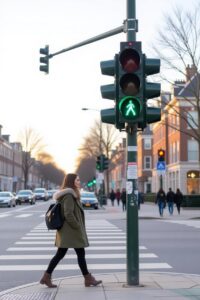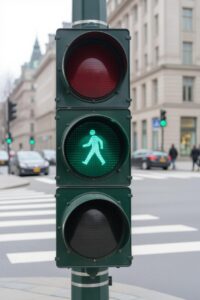Which Colour Follows The Green Signal At A Puffin Crossing
When navigating the UK’s pedestrian crossings—particularly the more advanced Puffin crossings—understanding the precise sequence of traffic light colours is essential for both pedestrian safety and smooth traffic flow.
Absolutely! Here’s a richly detailed and elongated introductory explanation—drawing from knowledgeable blog and guide sources—on which colour follows the green signal at a Puffin crossing.
Which Colour Follows The Green Signal At A Puffin Crossing?
In the intricate tapestry of urban infrastructure, pedestrian crossings stand as vital threads, weaving together the safety and mobility of foot traffic with the ceaseless flow of vehicles.
Among the various types of pedestrian crossings in the United Kingdom, the puffin crossing—short for Pedestrian User-Friendly Intelligent crossing—represents a modern evolution in road safety design, blending technology and practicality to prioritize pedestrian security while maintaining efficient traffic management.
Unlike its predecessor, the pelican crossing, the puffin crossing employs advanced sensors to adapt signal timings dynamically, ensuring that pedestrians, particularly those who may need more time to cross, are afforded the protection they require.
This innovation has made puffin crossings a fascinating subject for urban planners, road safety advocates, and everyday commuters alike, often explored in blogs dedicated to traffic systems, urban design, or public safety.
These blogs, ranging from government-backed road safety websites to independent transport enthusiast platforms, provide detailed insights into how puffin crossings function, their benefits over older systems, and the specific sequence of signals that guide both pedestrians and drivers.
One question that frequently arises in such discussions is the sequence of signals, particularly is which colour follows the green signal at a puffin crossing for pedestrians—an inquiry that not only reveals the mechanics of the crossing but also underscores the thoughtful engineering behind it.
Drawing from information commonly found in blogs discussing UK pedestrian crossings, such as those hosted by organizations like the Royal Society for the Prevention of Accidents (RosPA), local council websites, or transport-focused platforms like Driving.co.uk, the operation of a puffin crossing can be broken down with clarity.
At a puffin crossing, the green signal for pedestrian often depicted as a green walking figure—indicates that it is safe for individuals to begin crossing the road.
This signal is a beacon of assurance, particularly for vulnerable road users such as children, the elderly, or those with mobility challenges.
However, once this green signal phase concludes, the next color in the sequence for pedestrians is critical to ensuring safe transitions for both those on foot and drivers waiting to proceed.
After the green pedestrian signal, a red signal (typically a red standing figure) follows, instructing pedestrians not to start crossing, as the crossing phase has ended.
This red signal is a clear directive, ensuring that latecomers do not attempt to cross when the road is about to be relinquished to vehicular traffic.
For drivers, the sequence is equally important and slightly more nuanced,we have explained in detail on Green flashing beacon vehicle lights and who can use them.
Blogs often highlight that puffin crossings differ from pelican crossings in their use of intelligent sensors, which detect whether pedestrians are still on the crossing.
After the green signal for pedestrians ends, the traffic light for drivers, which has been red to halt vehicles, may remain red for an extended period if pedestrians are still detected. Once the crossing is clear, the red light for drivers is typically followed by a flashing amber light, signaling that drivers must continue to yield to any remaining pedestrians before proceeding.
This flashing amber is a key feature that promotes caution among drivers, ensuring that the crossing remains safe even as the signal transitions.
The emphasis on this signal sequence reflects not only the technical workings of puffin crossings but also their broader significance in fostering safer urban environments.
By exploring resources from road safety campaigns, government transport departments, or even enthusiast-driven blogs like those on Think Driving School or RAC’s website, you will gain a comprehensive understanding of how these crossings balance the needs of pedestrians and drivers, just like we explained on what shape are traffic signs giving orders for drivers.
The shift from the green pedestrian signal to the red pedestrian signal, coupled with the corresponding changes in driver signals, underscores the puffin crossing’s role as a dynamic, responsive system—one that adapts to real-time conditions to prioritize safety.
What’s The Duration Of Green Signal At A Puffin Crossing For Drivers?
The duration of the green signal at a puffin crossing is not fixed and depends on the presence of pedestrians, as detected by infrared sensors or pressure mats.
Unlike pelican crossings, which operate on a preset timer, puffin crossings (Pedestrian User-Friendly Intelligent crossings) use sensors to ensure the green signal for vehicles only changes to amber when the crossing is clear of pedestrians.
The green signal duration varies based on real-time pedestrian activity, typically lasting until all pedestrians have safely crossed, which can range from a few seconds to longer for busy crossings or slower-moving pedestrians (e.g., elderly or disabled individuals).
There is no standard duration specified in seconds, as it adapts dynamically to ensure pedestrian safety and efficient traffic flow.
Importance of Understanding Puffin Crossing Signals for Road Safety?

Understanding puffin crossing signals is crucial for road safety due to their unique, pedestrian-focused design and dynamic signal operation.
Below is a concise explanation of their importance, tailored to the context of puffin crossings and their traffic light sequence, same goes with who should obey diamond shaped traffic signs.
Why Understanding Puffin Crossing Signals Matters for Road Safety
1. Pedestrian Safety Through Dynamic Timing
Puffin crossings use infrared sensors or pressure mats to detect pedestrians, holding the red light for vehicles until the crossing is clear.
Knowing that the green signal for vehicles transitions to amber only when pedestrians are safely across prevents drivers from moving prematurely, reducing the risk of collisions with pedestrians.
2. Clarity in Signal Sequence
The sequence at a puffin crossing is red → red and amber → green → amber → red, with no flashing amber phase (unlike pelican crossings).
Understanding that amber follows green alerts drivers to prepare to stop, ensuring they don’t misinterpret the signal and proceed unsafely, which could endanger pedestrians.
3. Elimination of Ambiguity
Unlike pelican crossings, which have a flashing amber phase that can confuse drivers and pedestrians about right-of-way, puffin crossings provide clear signals. Recognizing that the amber light signals an immediate stop (lasting ~3 seconds) helps drivers avoid rushing through the crossing, enhancing safety.
4. Support for Vulnerable Road Users
Puffin crossings are designed to accommodate slower pedestrians (e.g., elderly, disabled, or children) by extending the pedestrian clearance phase as needed.
Awareness of this feature encourages drivers to remain patient during longer red phases, reducing accidents caused by impatience or misunderstanding.
5. Improved Traffic Flow and Reduced Confusion
By tailoring signal durations to real-time pedestrian presence, puffin crossings optimize traffic flow while prioritizing safety. Drivers who understand this adaptive system are less likely to make unsafe assumptions about signal timing, preventing abrupt stops or risky maneuvers.
6. Legal and Safety Compliance
Misinterpreting puffin crossing signals can lead to traffic violations, such as running a red light, which carries penalties in the UK (e.g., fines or points on a license). Knowledge of the correct sequence ensures compliance with traffic laws, fostering safer road environments.
7. Pedestrian Confidence and Predictability
Pedestrians rely on consistent vehicle behavior at crossings. When drivers and pedestrians both understand the signal sequence (e.g., green for vehicles means no pedestrian crossing, amber signals transition), it creates predictable interactions, reducing the likelihood of accidents.
Practical Implications
- For Drivers: Knowing that amber follows green and requires stopping prepares drivers to react promptly, avoiding collisions with pedestrians still in the crossing area.
- For Pedestrians: Understanding that sensors extend their crossing time encourages safe, unhurried movement, particularly for vulnerable users.
- For All Road Users: Familiarity with puffin crossings reduces confusion, promotes adherence to signals, and minimizes risks in high-traffic areas.
Summary To Which Colour Follows The Green Signal At A Puffin Crossing

At a puffin crossing, traffic lights guide vehicles through a sequence to ensure pedestrian safety. After the green signal, the next colour in the sequence is amber, warning drivers to prepare to stop as the lights are about to turn red.


